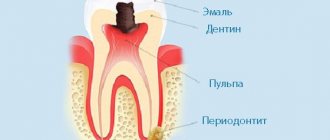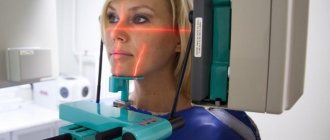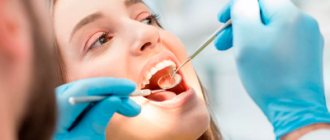- Causes of jaw inflammation
- What to do if the lower jaw is inflamed
- Diagnosis and treatment of jaw inflammation at the dentist
- Features of treatment for older patients
Inflammatory diseases are very common and are presented in all their diversity, from clinical manifestations to localization. Differential diagnosis is not always easy, especially if there are no specific signs. Often a dentist finds himself in this situation when a patient comes to him with inflammation under the jaw on the neck. In this case, it is very important to make a correct diagnosis and prescribe effective treatment.
Causes of jaw inflammation
The lower jaw and the area under it have a rather complex anatomical structure. Muscles, lymphatic and blood vessels, bone structures, etc. are concentrated in this zone. Also, the temporomandibular joint or other anatomical zones may be involved in the inflammatory process, from which the lesion spreads to the neck area. Common causes of inflammation of the jaw are:
- Tooth root cyst.
- Osteitis.
- Inflammation of the lymph nodes.
- Tumors of blood vessels and soft tissues of the neck.
- Traumatic injuries.
- Inflammation of the middle ear.
- Gingivitis, periodontitis, periodontal disease, etc.
Given such a variety of causes, the approach to diagnosis and treatment must be individualized. Due to his ignorance, the patient may choose the wrong doctor and waste his time. In situations where something is inflamed under the jaw on the right or left and at the same time a tooth or temporomandibular joint hurts, you need to consult a dentist. If the pain is localized in the ear area, then you need to visit an ENT specialist.
Causes of pain under the jaw
There are many reasons for pain in the neck and/or jaw, and they can indicate various health problems. There are many structures in the neck area, the pathologies of which cause pain and serious discomfort.
Pathological changes in lymph nodes
There are many lymph nodes behind our ears, on our neck, and in the lower part of our jaw. And one of the diseases that leads to painful discomfort is called lymphadenitis. This is inflammation of the lymph nodes due to bacterial or other infections. It is accompanied by severe sharp pain in the neck, which will radiate to the jaw, and will also cause an increase in body temperature. Without treatment, lymphadenitis becomes chronic, and then constant fatigue, weight loss and general malaise are added to the elevated temperature. Another pathology may be tumors that appear on the lymph nodes. These are, as a rule, metastases that have penetrated from any organs affected by cancer. The nature of the pain varies, but weakness and weight loss also accompany this condition.
Glossitis
Another disease that is associated with an inflammatory process, but does not affect the lymph nodes, but the tongue. Signs of glossitis are a bright red color of the tongue, severe swelling of the tongue and lower jaw. There may also be purulent discharge from the glands in the mouth, pain radiating to the ear, jaw and neck.
Pharyngitis, tonsillitis, sore throat
These diseases can also cause pain. But at the same time, if your neck hurts, then the pain radiates not under the jaw, but into the throat. With a sore throat, the pain intensifies at the time of swallowing, and the person also develops all the signs of an acute respiratory infection or flu (ear pain, fever, weakness, lack of appetite, etc.). For acute pharyngitis
Possible inflammation of the lymph nodes.
Jaw fractures
A fracture in the lower part of the jaw occurs due to a strong blow, head injury or accident. Fractures can be direct or reflected, multiple, fragmented, displaced, open or closed, but in any case the person experiences severe pain, which is accompanied by swelling, hemorrhage and impaired chewing function. In case of a fracture, you should immediately consult a doctor.
What to do if the lower jaw is inflamed
First of all, it is important to identify the symptoms of the problem. One of the very first and most obvious is an increase in soft tissue volume.
This can be either a slight swelling or a very large tumor-like formation. Other symptoms may include:
- Increased body temperature.
- Redness of the skin.
- Painful sensations.
- Incomplete opening or closing of the jaw.
- Sensation of a foreign body in the throat.
- Difficulty chewing or swallowing.
- Hearing loss.
If the symptoms are confusing and it becomes unclear which doctor you need to see, you can make an appointment with a therapist who will conduct an initial examination, examine the complaints and issue a referral to the right specialist.
Diagnosis and treatment of jaw inflammation at the dentist in Odintsovo
If inflammation of the jaw has developed due to diseases such as pulpitis, periodontitis, periodontitis, as well as as a result of injuries and damage to the temporomandibular joint, then the treatment will be carried out by a dentist. First, a specialist must establish an accurate diagnosis. To do this, he collects anamnesis, finds out complaints, and conducts a visual examination of the oral cavity. Additionally, an X-ray examination of the jaws, laboratory tests and other diagnostic tests may be prescribed, with the help of which it will be possible to obtain objective information about the condition of the patient’s dental system.
Treatment of inflammation in our clinic in Odintsovo is usually carried out using combined methods, which include:
- Conservative therapy. Typically, the dentist prescribes antibacterial, anti-inflammatory and painkillers.
- Surgery. It involves the removal of non-viable tissue, drainage of the inflammatory focus and, if necessary, other procedures that are aimed at eliminating the pathological area.
The duration and complexity of treatment largely depends on the degree of neglect of the process. The sooner a patient seeks medical help, the easier it will be to restore lost health.
Causes of neck pain
There are many reasons that can lead to cervicalgia. They are usually divided into two groups3:
- associated with the spine (vertebrogenic):
- osteochondrosis;
- arthrosis;
- infectious lesions of the skeleton;
- autoimmune pathologies;
- metabolic disorders;
- neoplasms;
- injuries.
- unrelated to the spine (non-vertebrogenic):
- myofascial syndrome;
- psychogenic pain syndrome;
- referred pain in diseases of internal organs3.
Let's take a closer look at the most common pathologies that can cause neck and head pain.
Up to contents
Osteochondrosis
Osteochondrosis is one of the most common problems of our time. It is manifested by deformation and thinning of the intervertebral discs.
Unfortunately, there is a tendency for osteochondrosis to appear at a young age; increasingly, this diagnosis is made even at the age of 204. Factors that can trigger the development of this disease4:
- hereditary predisposition;
- sedentary lifestyle;
- stress and overexertion4.
Most often, complications of osteochondrosis arise due to late consultation with a doctor. At the first stage, this disease practically does not bother you. There may be slight stiffness in the morning, a crunching sound when moving the head, a feeling of heaviness4. In this case, the inner part of the intervertebral disc loses moisture, and the outer part becomes covered with cracks and delaminates. The vertebrae begin to come closer together and injure each other4.
At the second stage, the vertebrae are subjected to excessive stress, and overstrain of muscles and ligaments appears. It is at this stage that intervertebral hernias and vertebral displacements can occur4.
Up to contents
Myofascial syndrome
The main cause of myofascial pain syndrome is constant or periodic overstrain of the neck muscles, which causes muscle fiber spasms5.
Risk factors5:
- curvature of posture;
- flat feet;
- heavy physical activity;
- constant overvoltage;
- vibration;
- prolonged immobile position of the body (for example, when treating fractures);
- wearing tight and uncomfortable clothes;
- eating disorders;
- diseases of internal organs5.
Taking these factors into account, it is difficult to imagine the variety of clinical cases in which myofascial syndrome occurs. In order to recognize this problem, it is important to pay attention to its main signs: muscle tightness, soreness and involuntary contractions7.
There are three degrees of myofascial pain syndrome6:
- First degree - painful sensations appear only when moving the head, as well as when pressing and stretching the affected muscle6.
- The second degree is a nagging pain in the entire neck that occurs spontaneously. You can detect a place where muscle tissue is hypertonic. When you press it, spasm and pain in neighboring areas are noted6.
- In the third degree, the entire back or side of the neck hurts severely, even at rest. The sensations become more pronounced with movement and pressure6.
Up to contents
Facet joint dysfunction
Facet joints connect the vertebrae to each other8. Their main function is to ensure stability of the spine by limiting its mobility9.
Acute joint pain occurs when the facet joint is injured during a sudden movement of the head or neck. The joint is pinched by the vertebrae, which leads to inflammation, swelling and pain in the neck area. Symptoms usually go away within a few days9.
Chronic dysfunction of the facet joints (facet syndrome) is more common in medical practice. This problem is associated with gradually developing changes in the structure of the joints9. Let's look at this process in more detail.
In healthy people, the facet joint is constantly exposed to stress. Gradually, the elastic core of the intervertebral disc, which is responsible for shock absorption and mobility, loses the water it contains, loses its elasticity and ceases to perform its functions properly. There is also a decrease in the height of the intervertebral discs. Under such conditions, increased load is transferred to the vertebrae and joints, causing degenerative changes in them9.
Facet syndrome is characterized by dull, monotonous pain in the neck, which worsens with prolonged sitting or standing in one position. Short-term pain in the morning is typical, decreasing after physical activity and increasing again in the evening9.
Unpleasant sensations sharply intensify when bending, turning and straightening the spine9. For example, if a person has pain in the back right of his neck, then it will be painful for him to turn his head in this direction. Unloading the spine - slight slow bending, as well as support under the back while sitting - brings relief9.
Up to contents
Hernias and protrusions of intervertebral discs
Herniated intervertebral discs are the most severe complication of osteochondrosis10. The following stages of their formation are distinguished:10
- Bulging (protrusion) of the disc.
- Prolapse of the nucleus and other fragments of the disc into the spinal canal (hernia itself).
- Hidden spondylolisthesis (displacement only during flexion and extension of the spine).
- Stabilization or self-healing10.
The first sign of intervertebral disc protrusion is increased pain with movement and its decrease at rest. Most often, patients with this problem feel worse when lying down, so they have to sleep half-sitting. The pain is pressing, bursting, often radiating to other areas3.
At the stage of a formed hernia, the spinal nerve or its roots are pinched. Manifestations are varied: pain in the neck, radiating to the shoulder and arm, changes in blood pressure, dizziness, weakness and drowsiness, numbness of the fingers, and in rare cases, hearing, vision and walking disorders11.
Up to contents
Cervical myelopathy
The cause of the development of cervical myelopathy is compression of the spinal cord and its vessels. This disease can be caused either by a herniated disc2 or by a narrowing of the diameter of the spinal canal due to degenerative changes in the vertebrae12. Myelopathy is more common in men over 50 years of age and develops gradually over 1-2 years2. As a rule, patients consult a doctor with the following complaints12:
- movement disorders (increased muscle tone, decreased strength, problems with coordination of movements);
- sensory disorders (changes in pain and joint-muscular sensitivity);
- reflex disorders (increased or decreased tendon reflexes of the arms and legs)12.
Up to contents
Injuries
Injuries to the cervical spine account for 55-80% of all spinal injuries13.
Whiplash injury (WHT) occupies one of the first places in the structure of cervical injuries14.
The term “whiplash” was first used in 1928 to refer to a specific injury to the neck during a vehicle collision13. After being hit by a car, the victim’s body moves sharply forward, and the head leans back; excessive extension occurs in the lower cervical segments of the spine15.
Most often, the cause of CTS is a traffic accident, but damage can also occur as a result of domestic, sports, industrial and combat injuries. In this case, the integrity of muscles, ligaments and soft tissues is violated, and in severe cases, vertebral fracture occurs14.
Depending on the victim’s complaints, there are 4 degrees of HTS15:
- the first is pain and limitation of head movement, pain when pressing the neck muscles;
- second - muscle spasms are detected, and when pressure is applied, pain points are detected;
- third - neurological manifestations are added: decreased reflexes to the point of their absence, partial paralysis, impaired sensitivity;
- fourth - fracture and displacement of the cervical vertebrae, prolapse of intervertebral discs15.
Common symptoms of neck injuries include dizziness and headache, noise and ringing in the ears, changes in skin color (pale, blue or red), increased sweating and nervous system disorders: obsessive thoughts, apathy, depression, acute outbursts of fear15 .
Up to contents
Features of treatment for older patients
Among the common age-related changes in the lower jaw, changes in the content of water, organic and inorganic substances are noted, osteoporosis, atrophy and thinning of bone tissue are often detected. In addition, older patients often have concomitant diseases, such as diabetes. All of these factors can greatly limit treatment options. For example, if dentures are required, then in some situations the dentist may only offer removable dentures. Placing implants will be risky and ineffective.
Nevertheless, modern dental capabilities make it possible to find a way out of any, even the most difficult situation. A wide variety of materials and techniques can eliminate existing problems and significantly improve the patient’s quality of life.











